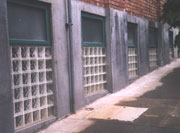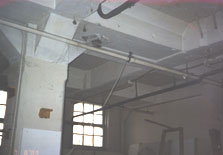| Now
I want to turn for a moment to the issue of historical
integrity.
Integrity
is based, in part, on the criterion for which a property
is being nominated. For a building of architectural significance,
the alteration of any feature could disqualify it from
landmark status. For properties primarily of historical
significance, the bar is lower.
 The
National Register identifies seven characteristics of
integrity: location, design, setting, materials, workmanship,
feeling, and association. The
National Register identifies seven characteristics of
integrity: location, design, setting, materials, workmanship,
feeling, and association.
Some
of these, such as integrity of location, are quite rigidly
enforced: a building that is moved can rarely achieve
National Register status. More leeway, however, is allowed
in other areas. I mentioned before the example of the
Munsingwear Building and its 1960s glass-block windows.
A
more extreme example is the original terminal at the
Minneapolis-St. Paul Airport. This two-story building,
placed in service in 1930, subsequently received a third
story and a series of other additions. Just after World
War II, two hangars built in the 1920s were moved across
the field and attached to the front of the terminal
for "temporary" passenger and office space
- and, of course, they are still there. Despite these
changes, the building has been determined eligible for
the National Register.
The
changes, in fact, are an important reflection of the
growth of the aviation industry in the 1930s and 1940s.
 On
the Seattle Empire Laundry Building, the pattern of
fenestration is maintained, and almost all the original
sash remains on the north side. On
the Seattle Empire Laundry Building, the pattern of
fenestration is maintained, and almost all the original
sash remains on the north side.
The
original sash on the other facades featured double-stacked,
horizontally pivoting windows in groups of three per
opening.
Replacement sash on these facades echoes the vertical
tripartite division of the original sash and, on the
first and second floors, the four tiers of panes of
the double-stacked pivoting windows.
As
I mentioned above, even though most of the windows were
filled with glass block, the Munsingwear Building was
listed in the National Register, which has exacting
standards for integrity.
The
integrity of the Empire Laundry'Ss windows is far
better, and other changes to the exterior of the building
are minor. The interior, although more altered, still
retains vestiges of its laundry days, such as the drying
room area, stairs, once-hydraulic elevator - even traces
of the old machinery (see photo above left).
|